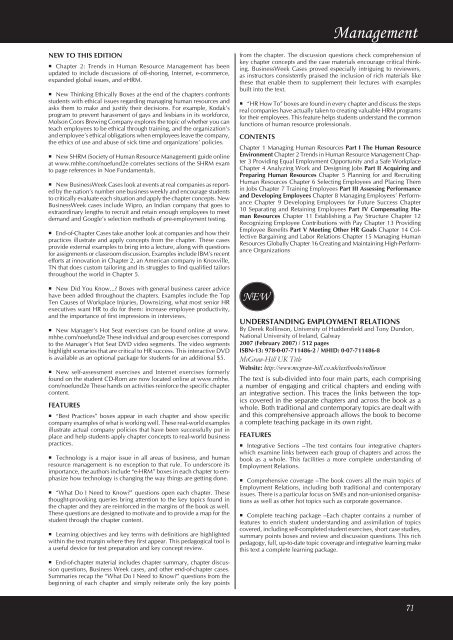Business Communication - McGraw-Hill Books
Business Communication - McGraw-Hill Books
Business Communication - McGraw-Hill Books
You also want an ePaper? Increase the reach of your titles
YUMPU automatically turns print PDFs into web optimized ePapers that Google loves.
ManagementNEW TO THIS EDITION• Chapter 2: Trends in Human Resource Management has beenupdated to include discussions of off-shoring, Internet, e-commerce,expanded global issues, and eHRM.• New Thinking Ethically Boxes at the end of the chapters confrontsstudents with ethical issues regarding managing human resources andasks them to make and justify their decisions. For example, Kodak’sprogram to prevent harassment of gays and lesbians in its workforce,Molson Coors Brewing Company explores the topic of whether you canteach employees to be ethical through training, and the organization’sand employee’s ethical obligations when employees leave the company,the ethics of use and abuse of sick time and organizations’ policies.• New SHRM (Society of Human Resource Management) guide onlineat www.mhhe.com/noefund2e correlates sections of the SHRM examto page references in Noe Fundamentals.• New <strong>Business</strong>Week Cases look at events at real companies as reportedby the nation’s number one business weekly and encourage studentsto critically evaluate each situation and apply the chapter concepts. New<strong>Business</strong>Week cases include Wipro, an Indian company that goes toextraordinary lengths to recruit and retain enough employees to meetdemand and Google’s selection methods of pre-employment testing.• End-of-Chapter Cases take another look at companies and how theirpractices illustrate and apply concepts from the chapter. These casesprovide external examples to bring into a lecture, along with questionsfor assignments or classroom discussion. Examples include IBM’s recentefforts at innovation in Chapter 2, an American company in Knoxville,TN that does custom tailoring and its struggles to find qualified tailorsthroughout the world in Chapter 5.• New Did You Know...? Boxes with general business career advicehave been added throughout the chapters. Examples include the TopTen Causes of Workplace Injuries, Downsizing, what most senior HRexecutives want HR to do for them: increase employee productivity,and the importance of first impressions in interviews.• New Manager’s Hot Seat exercises can be found online at www.mhhe.com/noefund2e These individual and group exercises correspondto the Manager’s Hot Seat DVD video segments. The video segmentshighlight scenarios that are critical to HR success. This interactive DVDis available as an optional package for students for an additional $5.• New self-assessment exercises and Internet exercises formerlyfound on the student CD-Rom are now located online at www.mhhe.com/noefund2e These hands on activities reinforce the specific chaptercontent.FEATURES• “Best Practices” boxes appear in each chapter and show specificcompany examples of what is working well. These real-world examplesillustrate actual company policies that have been successfully put inplace and help students apply chapter concepts to real-world businesspractices.• Technology is a major issue in all areas of business, and humanresource management is no exception to that rule. To underscore itsimportance, the authors include “e-HRM” boxes in each chapter to emphasizehow technology is changing the way things are getting done.• “What Do I Need to Know?” questions open each chapter. Thesethought-provoking queries bring attention to the key topics found inthe chapter and they are reinforced in the margins of the book as well.These questions are designed to motivate and to provide a map for thestudent through the chapter content.• Learning objectives and key terms with definitions are highlightedwithin the text margin where they first appear. This pedagogical tool isa useful device for test preparation and key concept review.from the chapter. The discussion questions check comprehension ofkey chapter concepts and the case materials encourage critical thinking.<strong>Business</strong>Week Cases proved especially intriguing to reviewers,as instructors consistently praised the inclusion of rich materials likethese that enable them to supplement their lectures with examplesbuilt into the text.• “HR How To” boxes are found in every chapter and discuss the stepsreal companies have actually taken to creating valuable HRM programsfor their employees. This feature helps students understand the commonfunctions of human resource professionals.CONTENTSChapter 1 Managing Human Resources Part I The Human ResourceEnvironment Chapter 2 Trends in Human Resource Management Chapter3 Providing Equal Employment Opportunity and a Safe WorkplaceChapter 4 Analyzing Work and Designing Jobs Part II Acquiring andPreparing Human Resources Chapter 5 Planning for and RecruitingHuman Resources Chapter 6 Selecting Employees and Placing Themin Jobs Chapter 7 Training Employees Part III Assessing Performanceand Developing Employees Chapter 8 Managing Employees’ PerformanceChapter 9 Developing Employees for Future Success Chapter10 Separating and Retaining Employees Part IV Compensating HumanResources Chapter 11 Establishing a Pay Structure Chapter 12Recognizing Employee Contributions with Pay Chapter 13 ProvidingEmployee Benefits Part V Meeting Other HR Goals Chapter 14 CollectiveBargaining and Labor Relations Chapter 15 Managing HumanResources Globally Chapter 16 Creating and Maintaining High-PerformanceOrganizationsNEWUNDERSTANDING EMPLOYMENT RELATIONSBy Derek Rollinson, University of Huddersfield and Tony Dundon,National University of Ireland, Galway2007 (February 2007) / 512 pagesISBN-13: 978-0-07-711486-2 / MHID: 0-07-711486-8<strong>McGraw</strong>-<strong>Hill</strong> UK TitleWebsite: http://www.mcgraw-hill.co.uk/textbooks/rollinsonThe text is sub-divided into four main parts, each comprisinga number of engaging and critical chapters and ending withan integrative section. This traces the links between the topicscovered in the separate chapters and across the book as awhole. Both traditional and contemporary topics are dealt withand this comprehensive approach allows the book to becomea complete teaching package in its own right.FEATURES• Integrative Sections --The text contains four integrative chapterswhich examine links between each group of chapters and across thebook as a whole. This facilities a more complete understanding ofEmployment Relations.• Comprehensive coverage --The book covers all the main topics ofEmployment Relations, including both traditional and contemporaryissues. There is a particular focus on SMEs and non-unionised organisationsas well as other hot topics such as corporate governance.• Complete teaching package --Each chapter contains a number offeatures to enrich student understanding and assimilation of topicscovered, including self-completed student exercises, short case studies,summary points boxes and review and discussion questions. This richpedagogy, full, up-to-date topic coverage and integrative learning makethis text a complete learning package.• End-of-chapter material includes chapter summary, chapter discussionquestions, <strong>Business</strong> Week cases, and other end-of-chapter cases.Summaries recap the “What Do I Need to Know?” questions from thebeginning of each chapter and simply reiterate only the key points71HED 2007 Management.indd 7110/5/2006 1:24:18 PM

















